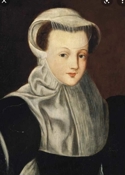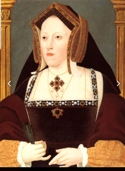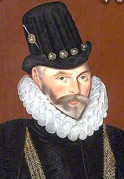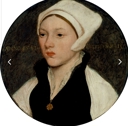Elizabethan Hats For Every Head
 When most people think of Elizabethan hats, they think of the big, floppy hats that were popular during that time period. However, there were many different types of hats worn by both men and women during the Elizabethan era. In this blog post, we will take a look at the history and construction of some of the most popular Elizabethan hats.
When most people think of Elizabethan hats, they think of the big, floppy hats that were popular during that time period. However, there were many different types of hats worn by both men and women during the Elizabethan era. In this blog post, we will take a look at the history and construction of some of the most popular Elizabethan hats.A few notations before we begin. In the Elizabethan era , and previously, hats were considered a must have for outdoors and mostly indoors as well. Even the humblest of persons observed this, even if it was only a simple kerchief on the head. To fail to do so was considered sloppy and immoral. If you are thinking of gathering or sewing garb for a Renaissance Faire consider adding a hat to your ensemble. There are several types of easy or inexpensive hats that are historically correct and match perfectly any class from peasant to royalty.
Elizabethan fashion was all about spangles, embroidery and feathered adornment. For hats such as coifs and cauls embroidery (if desired) is appropriate. Other hats like the tall, flat and soft caps are usually adorned with a feather or two and while a basic French or gabled hood are possible most were trimmed with beads, stones or pearls. But choices for many classes were limited because of the advent of sumptuary laws.
 Sumptuary laws were a set of laws governing how fancy any given class's clothing was permitted to wear. For example, only nobility could wear certain kinds of fur, no matter if your financial situation could purchase such fine things. Sumptuary laws were largely laws drawn up by class. The higher your class, the more you were able to legally wear. The penalties were usually a fine of some sort.
Sumptuary laws were a set of laws governing how fancy any given class's clothing was permitted to wear. For example, only nobility could wear certain kinds of fur, no matter if your financial situation could purchase such fine things. Sumptuary laws were largely laws drawn up by class. The higher your class, the more you were able to legally wear. The penalties were usually a fine of some sort.First let us discuss unisex hats. The simplest of unisex hats is the coif, also known as a biggin. This basic hat made usually of white or off-white linen or muslin, is cut to hug the head much in the style of what we in modern times might compare to a baby bonnet. Children wore these regularly and they can be worn with or without ribbons to tie under the chin. This hat was often trimmed with embroidery. This method of adornment was very common as it did not require many materials only thread and time. Other trimmings such as feathers, pearls and spangles required more money that those in the lower classes had to spend in addition to the issue of sumptuary laws.
The second unisex hat is a soft cap. This is a hat that is made usually of velvet, brocade or silk and is free form. It is very simple with a slightly stiffened brim slightly puffed top and often adorned with feathers. It is meant to be worn at an angle and can be worn over a coif or caul as well. In modern day costume/garb recreation due to their simplicity
 they can also be made to match only one gown/outfit and the feather pin reused. In the past they often were made of long enduring common colors such as navy, black or brown.
they can also be made to match only one gown/outfit and the feather pin reused. In the past they often were made of long enduring common colors such as navy, black or brown.The flat cap is next of the unisex hats. It is very similar to the soft cap with a slightly stiffened brim, but the crown is much like a beret. The brim and more fitted crown are sewn together to complete the hat. This can also be worn at an angle over a coif, caul or snood.
The last unisex hat is the tall cap. This hat is more labor intensive but extremely flattering to both sexes when done correctly. It is made with a very stiff brim, tall sides and stiffened crown. It can remind one of a top hat although it is not nearly so boxy. The fabric covering the sides of the hat can be pleated for a very flattering effect. These are almost always adorned with a brooch or feathered trim.
Moving on to the women's hats lets talk about the Gabled Hood. This is a complex hat that looks very much like a house on the head with the hat sitting on the head like a tiara. I have seen this done in a very flattering way, although it is not my style. Many Gabled Hoods were made with multiple pieces covered in multiple fabrics. Pleated fabric, pearls,
 beads and stones were often used to trim. They did not have any embroidery. This hat was meant to frame the face with a veil in the back, usually black.
beads and stones were often used to trim. They did not have any embroidery. This hat was meant to frame the face with a veil in the back, usually black.Next is a French Hood. This is a similar hat in that it has a face framing crescent shape. These were most often made in black with a black veil in the back. A jewelry piece called a biliment framed the crescent. This is a hat that is universally flattering and my personal favorite.
The last variation of hoods is the attifet. This sits on the crown of the head with a heart shape framing the face. It is often made with millinery wire, buckram, and trimmed with white lace. The veil in the back can be either white or black. This was a hat introduced to popularity by Mary, Queen of Scots, cousin to and sometimes prisoner, of Elizabeth I.
This covers some basic Tudor and Elizabethan Renaissance hats.
Now you can put the finishing touches on your next outfit with the perfect hat!
The last variation of hoods is the attifet. This sits on the crown of the head with a heart shape framing the face. It is often made with millinery wire, buckram, and trimmed with white lace. The veil in the back can be either white or black. This was a hat introduced to popularity by Mary, Queen of Scots, cousin to and sometimes prisoner, of Elizabeth I.
This covers some basic Tudor and Elizabethan Renaissance hats.
Now you can put the finishing touches on your next outfit with the perfect hat!


